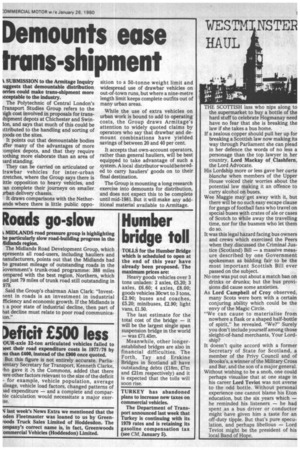Demounts ease trans-shipment
Page 7

If you've noticed an error in this article please click here to report it so we can fix it.
k SUBMISSION to the Armitage Inquiry ;uggests that demountable distribution, orries could make trans-shipment more icceptable to the industry.
The Polytechnic of Central London's fransport Studies Group refers to the ugh cost involved in proposals for transthipment depots at Chichester and SwinIon, and says that much of this could be ittributed to the handling and sorting of ;oods on the sites.
It points out that demountable bodies )ffer many of the advantages of more ;omplex depots, and that they require iothing more elaborate than an area of lard standing.
They can be carried on articulated or irawbar vehicles for inter-urban aretches, where the Group says there is ittle opposition to heavy vehicles, and ;an complete their journeys on smaller irban delivery chassis.
It draws comparisons with the Netherands where there is little public oppo sition to a 50-tonne weight limit and widespread use of drawbar vehicles on out-of-town runs, but where a nine-metre length limit keeps complete outfits out of many urban areas.
While the use of extra vehicles on urban work is bound to add to operating costs, the Group draws Armitage's attention to widely quoted claims by operators who say that drawbar and demount combinations have yielded savings of between 20 and 40 per cent.
It accepts that own-account operators, rather than general hauliers, will be best equipped to take advantage of such a system. A local distributor would be needed to carry hauliers' goods on to their final destination.
The Group is mounting a long research exercise into demounts for distribution, and does not expect this to be complete until mid-1981. But it will make any additional material available to Armitage.












































































































































